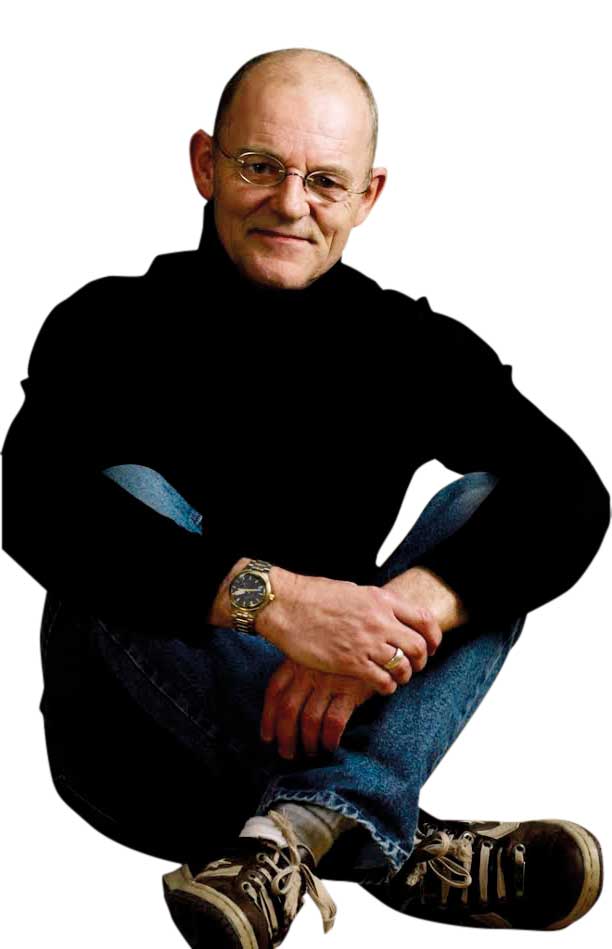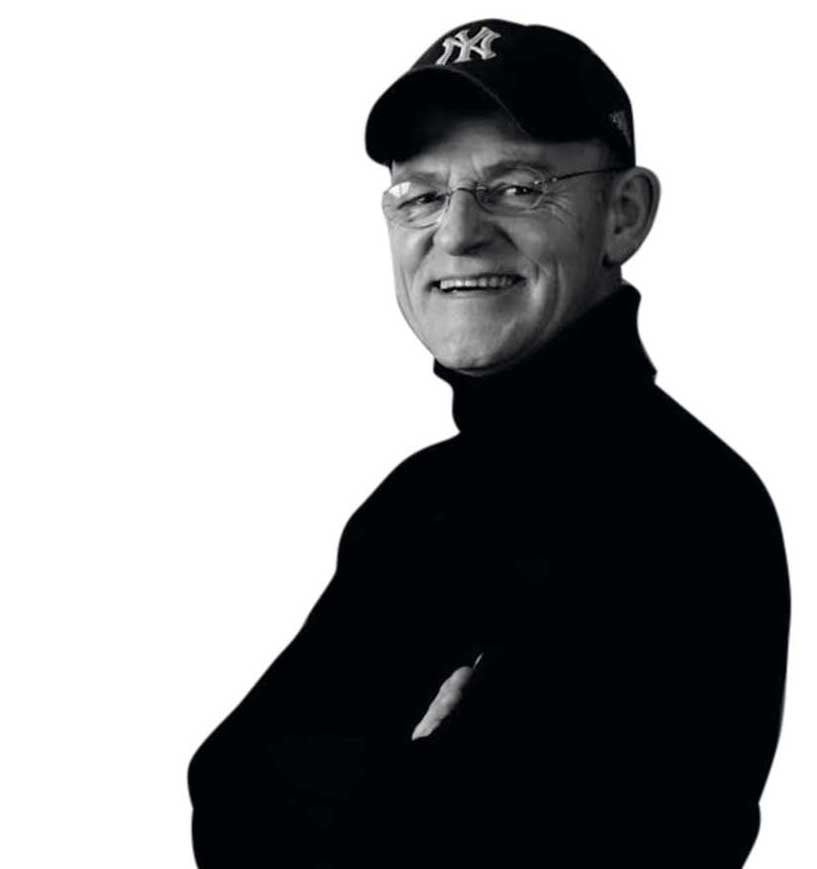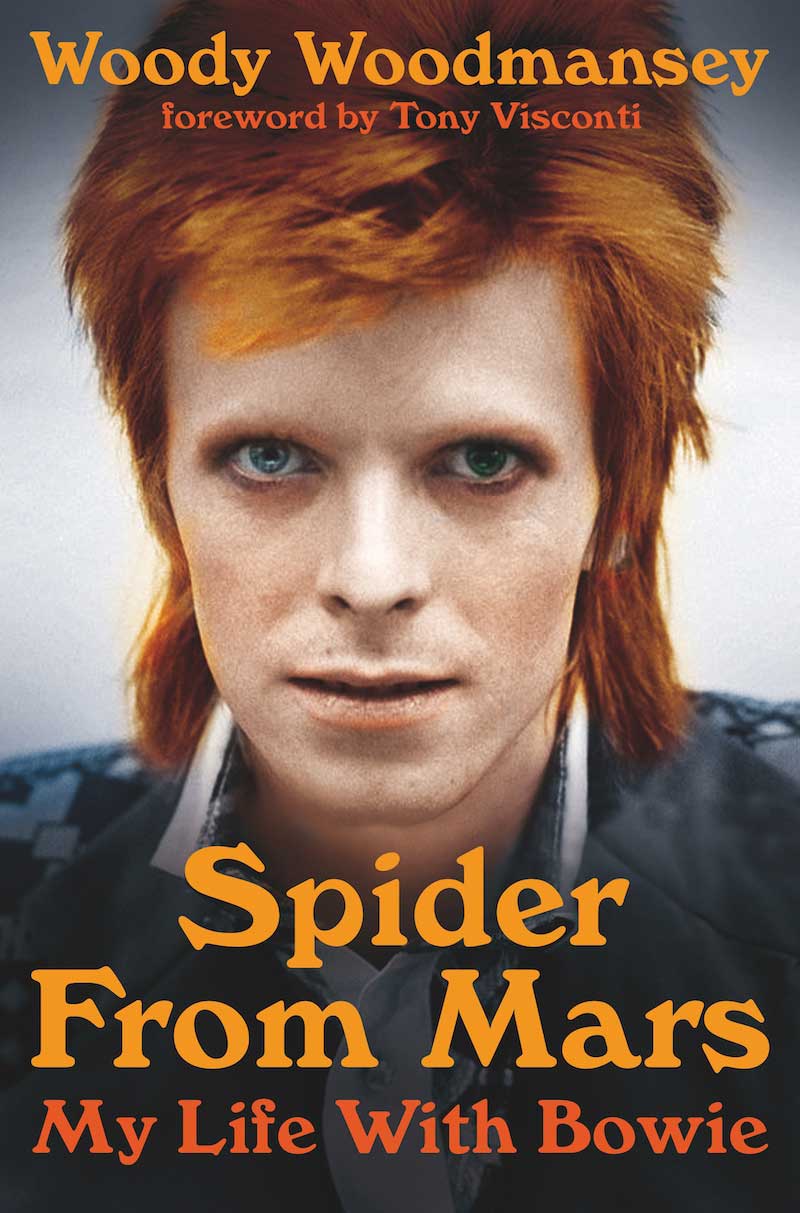
As one of the Spiders From Mars, Woody Woodmansey played with David Bowie on four seminal albums. In 2017 he spoke to Richard Purden about his remarkable career…
Outside Glasgow’s Royal Concert Hall, Woody Woodmansey is having a smoke before appearing at the city’s Aye Right! Book Festival to discuss his recent autobiography Spider From Mars: My Life With Bowie. It’s not long before fans are asking him for selfies and he’s happy to oblige.
“I’ve waited 45 years for this” suggests one as he clicks the long-awaited shot. Another fan walks past in a Bowie t-shirt referencing the legendary Ziggy concert at Green’s Playhouse here in January 1973.
Woodmansey takes a drag and blows smoke into the damp Scottish air. His wife June suggests it’s showtime and they leave the growing crowd to disperse.
Sitting down backstage I ask him if he remembers the aforementioned show at Green’s which came on the back of a Top Of The Pops performance of The Jean Genie.
The lost footage emerged in 2011, 38 years after the original broadcast which was considered to have been wiped. “I hadn’t forgotten about the Top Of The Pops performance all those years,” confirms Woody.
“I always knew that we’d done it because the band had been on the road in America and the version we were playing was really cooking, it was a different arrangement that included a bit of Love Me Do.
“We only agreed to do the show if they let us play live and the producer said yes. Green’s was the day after the broadcast, the Scottish audiences were great, after the gig our car was surrounded with hundreds of fans banging on the glass.
- Read more: Making David Bowie: “Heroes”
“We thought the window was going to cave in and we could see it cracking. There was a policeman standing in front of the motor and we just had to tell the driver to go, we ran over the cop’s foot but it was him or us.”
Three years earlier Woodmansey had found himself in a dilemma, after being offered a secure, practical job in his hometown of Driffield, North Yorkshire, he received a phone call out of the blue from David Bowie with an invitation to join his band in London.
Woodmansey admits that he viewed the singer as “a folk musician, it’s not a stretch to say he was seen as a one hit wonder after Space Oddity”.
Sitting down after the call he then imagined a settled vision of domestic life in the future as an elderly man who didn’t take his chance.
“For a moment, it was as if life stopped, I thought this is my future if I take this job and I began to freak out. If I went with Bowie I might come back in rags, cut and bruised in the gutter, my friends might call me a wanker but at least I could say that I tried”.
Face the strange
Woodmansey, along with guitarist Mick Ronson, who had recommended the drummer, moved into Haddon Hall, the Victorian villa in Beckenham (now demolished) where David lived with his soon-to-be wife Angie.
It was a new creative chapter for the singer, which would find Bowie harnessing Ronson and Woodmansey’s Cream and Jeff Beck-influenced leanings while singing of magical other worlds, mental illness, supermen and strange machines on The Man Who Sold The World.
“We were still immersed in the progressive thing, we would jam over his chords, lyrics and melody but he left it quite open.”
With the addition of Trevor Bolder on bass for the recording of Hunky Dory, the Spiders line-up was now complete.
Despite a lack of success Woodmansey was in no doubt of Bowie’s talent for writing pop songs with avant garde leanings and complex philosophical ideas. Many of the tracks would help define Bowie and the era.

“We were still living in Haddon Hall and David was now writing the likes of Changes, which got a lot of airplay as a single but didn’t sell. When you’ve played on a track like Life On Mars it just cut through everything else that was going on, he was so far ahead of what was happening.
“There was a big shift in the quality of his songwriting, at one point I asked myself if I believed in this or not and the answer was yes. In the band, we were all on £7 a week but it was worth it, it was worth the burnt food and the sleeping bags.
“When we were putting Life On Mars together David’s mum Peggy came to the house. In the house a lot of musicians would come and play at parties, one morning I got up and there were a few Vogue models downstairs – it could get a bit crazy at times but on Sundays we’d try to have lunch and a normal sort of day.
“Ronno was working on the arrangement for Life On Mars in the toilet, he’d sometimes worry and get nervous before recording them but he was really coming into his own by this point.
“On this occasion, he came out of the toilet bollock-naked just as David’s mum was coming up the stairs with a pot of tea. We just heard this blood-curdling scream, he got the name Flasher Ronson for a while after that.”
We were Ziggy’s band
For his breakthrough album The Rise and Fall of Ziggy Stardust and the Spiders from Mars Bowie would arrange the sensibilities of 50s rock’n’roll and the androgyny he had cultivated on previous album sleeves.
The image was blended with a new kind of street energy, science fiction and an uncanny strangeness.
The now iconic cover found Bowie with freshly cropped, Modish hair and wrestling boots, there was a hint of violence in his swaggering stance and droog jumpsuit inspired by A Clockwork Orange.
Photographer Brian Ward had perhaps hoped to summon more of that energy by persuading the band to join him as Woodmansey explains: “It was a weird concept and we got into various poses upstairs in Brian’s studio, he suggested we go outside but it was absolutely pissing down and cold.
“I felt we’d done enough and was like ‘fuck off; it’s freezing’ but David was up for it, he went outside and that was the shot.”
- Read more: David Bowie in the 90s
The album would begin with Five Years, an apocalyptic vision of the future being announced by a rock star from outer space; on the album’s closer Ziggy declared his messianic farewell during the stirring torch song Rock ’n’ Roll Suicide.
Although rich in concepts and imagination the record company felt something was missing.
“They wouldn’t release it because it didn’t have a single,” explains Woodmansey. “David’s response was to go home and write Starman. He had that ability to write a hit when he needed to, the thing was he didn’t always want to do that.”
With Starman and its nod to Somewhere Over The Rainbow from The Wizard Of Oz he dispensed an affecting presentation of the familiar and the strange wrapped up in a pop single.
With pending television appearances and a British tour Bowie further cultivated Ziggy and the Spiders’ image for both.
“For us to pull it off we couldn’t look like this blues band from Hull behind him with the arse hanging out of our trousers, you had to find your place behind Ziggy, we were now aliens playing rock’n’roll.
“One time in the studio he announced that he was taking us to see a play, our attitude was ‘that’s not very rock’n’roll – what’s it called?’, David said: ‘I don’t give a fuck what it’s called, the lighting guy is the best in London, just watch the lights and don’t bother with the play’.
“Another time he took us to the ballet, again it was the lighting, it was all about adding to the sense of theatre, drama and atmosphere for the live show.”
Bowie subtly suggested further changes to clothes, hair and makeup, it was a gradual process that had to be handled tentatively.
Woody said: “We went to a shop in the Kings Road, he’d say: ‘this is what you are going to wear’, handing Mick a gold jumpsuit which went with his blonde hair, Trevor was given a blue velvet jacket, I realised that all was left was fucking pink.
“David said to me: ‘it takes a real man to wear pink’ and I fell for it. It was the same with the makeup, we were getting ready for a television show and he said to us: ‘it’s a shame you’re not wearing makeup’. I said: ‘why, what do you mean?’
“He came over, looked at me and said: ‘bright studio lights pulls all the flesh colour out of your face and makes it look green. It wasn’t true but we saw the effect it was having on girls. In the end we’d be going to the shops for a pint of milk and putting our makeup on beforehand”.
Let all the children boogie
Ten years after forming his first band, the moment that would propel Bowie to stardom arrived with an appearance on Top Of The Pops performing Starman in July 1972.
Providing a hit record was secured, you could be broadcast into living rooms across Britain at prime time. With his now flame red hair and multi-coloured jumpsuit, Bowie had finally captured the public’s imagination with one of his most captivating singles yet.
The Spiders, who had been largely confined to the studio and Bowie’s basement in Haddon Hall, were about to play an extensive tour of the UK, US and Asia. While on the road across the US, Bowie began writing Aladdin Sane.

Woody said: “We recorded in different cities, usually where there was an RCA studio. Although the Ziggy… and Hunky Dory albums were produced as rock records they were compressed songs, when you take that on the road you play according to the size of the venue.
“By the time we hit America and were playing in 10,000-seaters, our rock roots came out; you feel like you have to lay it on a bit more. The guitars became raunchier, everything got louder and went up a level which affected the recording of Aladdin Sane.
“It was good to have that influence from playing live, it was more energetic and was also weirder because of Mike Garson’s jazz piano on tracks like Time. You never knew where it would all end up. In the band, we took each track on merit and played what felt right.”
Got a good thing going
Ziggy and the Spiders would reach their peak unexpectedly at the beginning of July 1973, almost exactly a year to the day since Bowie pointed the way forward on Top Of The Pops. The Ziggy tour would end with two performances at the Hammersmith Odeon.
D.A. Pennebaker’s film of the final night, Ziggy Stardust And The Spiders From Mars, proved to be an essential document capturing a build-up of fan hysteria and the backstage energy of Bowie’s rapid costume changes as Angie Bowie and Ringo Starr flit in and out.
When Bowie announced that the performance would be “the last show that we’ll ever do” from the stage, the next day’s print headlines were secured.
It was Woodmansey’s final performance with Bowie. Significantly, Mick Ronson and Trevor Bolder would play on his next long-player, the covers album Pin Ups. They would also make one final live appearance alongside him for American television.
“It was a major upset in my life,” says Woodmansey. “I was on stage and had just got the sack. To make it worse, it’s going to be in a film that goes out worldwide in cinemas. We had done some rehearsal for Pin Ups but about 10 minutes after getting married
“I received a phone call and was told my services were no longer required by the manager and that I wouldn’t be going to France to record, it just felt as if everything had been ripped away.”
Bowie’s drug use had intensified and financial disagreements with the Spiders had created some discord. “We did make up,” adds Woody, “I was in France doing some session work and David was recording Low, he invited me to dinner and we went through everything.
“He told me a lot that I didn’t know, I didn’t have a clue about the drugs, he was still trying to handle that. He spoke about how much it meant going from being a relative unknown to being up there, a star is born kind of thing.
“He said: ‘I’ll never get that again’. The Ziggy thing was so massive and he was having a hard time with it, he was in this rock god bubble and we couldn’t get through it sometimes but it was also such a solidly creative period as well.”
It appears that Woody Woodmansey made the right choice.
Photos by Stephanie Rushton
The post Woody Woodmansey – a Spider’s tale appeared first on Classic Pop Magazine.





